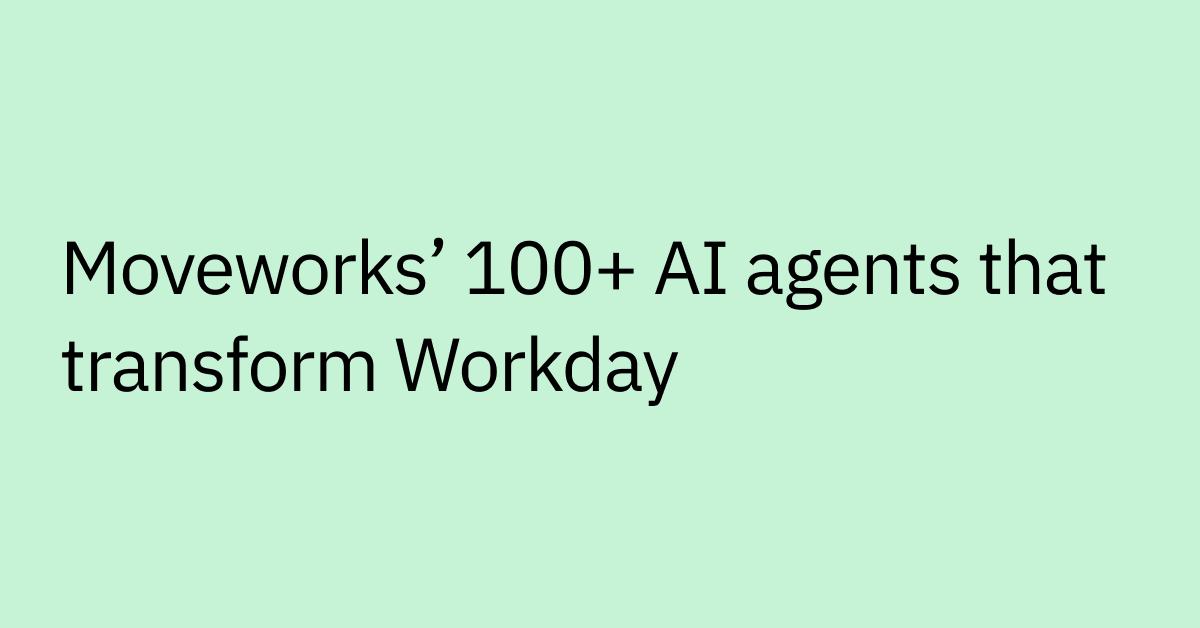Table of contents
Highlights
- An enterprise automation strategy aligns people, processes, and technology to streamline work and scale innovation.
- Success depends on clear goals, stakeholder alignment, and integration across existing systems and workflows.
- Agentic AI introduces adaptive automation that reasons, plans, and acts across complex business environments.
- Strong governance, security, and change management enable adoption and long-term value realization.
- Moveworks empowers enterprises to operationalize automation with AI agents that are able to orchestrate tasks across all business systems.
According to a McKinsey report, up to 30% of work hours currently performed by employees across the U.S. could potentially be automated by 2030.
You know that automation is important for staying competitive — but without a clear roadmap, enterprise automation investments often become siloed, underused, or fail to adapt as business needs change.
When it comes to your automation strategy, you’re looking to stay ahead of the curve, anticipate challenges, and balance priorities, such as:
- Managing integrations with existing systems and processes
- Handling organizational change
- Herding your stakeholders into alignment
Taking smart approach to enterprise automation strategy right from the get go helps you to avoid fragmented efforts, maximize return on investment (ROI), and ensure automation initiatives are aligned with your broader business objectives.
That’s why we’ll share the key elements of an effective automation strategy, discuss how to build your automation roadmap in four steps, while also giving you actionable tips to execute your strategy successfully along the way.
What is an enterprise automation strategy?
An enterprise automation strategy is a roadmap that guides how your organization identifies, prioritizes, and implements automation solutions to support your key business priorities. It involves using automation technologies—such as AI agents, robotic process automation (RPA), and workflow tools to:
- Identify which business initiatives and processes should be automated
- Streamline complex workflows to improve efficiency
- Capture stakeholder requirements
- Align automation solutions with business needs
- Driving change management and communication to support adoption
Enterprise automation goes well beyond basic task execution or simple workflow management by leveraging advanced tools like RPA, AI agents, and ML, to manage complex, multi-step workflows across different teams and systems.
Traditional automation tools often handle simpler tasks such as data entry or sending email notifications. In contrast, enterprise-grade automation platforms use intelligent automation, agentic AI, or AI-driven process orchestration to manage end-to-end processes like employee onboarding—automating everything from account creation across multiple systems to assigning role-based access permissions, all while ensuring compliance with security policies.
Why enterprises need a strategy before they automate
Jumping into automation without a clear strategy can lead to fragmented tools, poor adoption among employees, and redundant solutions that drain budgets without delivering meaningful results.
When you start automating tasks reactively, you can end up with point solutions that address individual problems but don’t work together or scale.
For example, your finance team might use one platform for invoice processing, while HR has a separate system for onboarding, and IT has another for help desk automation.
These disconnected systems can create even more problems as data silos emerge, employees have to deal with multiple interfaces, and IT teams spend more time managing vendor relationships than driving innovation.
Without executive buy-in, well-defined goals, and strong stakeholder alignment, automation initiatives can stall — or worse, fail to deliver business value.
A thoughtful strategy ensures you:
- Prioritize high-impact use cases
- Promote consistent adoption
- Lay the foundation for automation that grows with your organization
Key elements of an effective automation strategy
Each of these core pillars works together to ensure your automation efforts are scalable, efficient, and impactful across the business.
Clear objectives and stakeholder alignment
Capturing stakeholder requirements and aligning automation solutions with business needs involve engaging stakeholders early to understand their expectations and documenting the specific behaviors and capabilities required from the automation solution.
Start by defining what your organization wants to achieve with automation. Whether it's cost savings, improved productivity, or better employee experience, these goals should tie directly to broader business objectives and have measurable outcomes.
Integration with existing systems
Your automation strategy should account for your existing technology investments. The most effective approaches build on your existing tech stack instead of requiring an overhaul of the entire ecosystem. This also helps reduce implementation risk and accelerate time to value.
The role of AI in adaptive automation
Agentic AI refers to intelligent systems that can reason, make decisions, and take actions autonomously — going beyond static, rule-based automation.
Intelligent automation understands context, handles exceptions, and improves over time, making it far more scalable and effective than traditional approaches.
Security, compliance, and governance
These considerations become critical when deploying automation across your tech stack. IT leaders need frameworks for access controls, data protection, and regulatory compliance.
Strong governance not only ensures security standards are met — it also helps reduce risk and enable innovation at scale.
How to build an automation roadmap in 4 steps
Creating an automation roadmap means balancing quick wins with long-term transformation goals. This helps you build momentum while laying the foundation for enterprise-wide automation success.
1. Define goals and identify high-impact automation opportunities
Begin by understanding your stakeholder requirements and aligning automation solutions with business needs. This involves engaging stakeholders early to understand their expectations and documenting the specific behaviors and capabilities required from the automation solution.
This lets you establish a clear vision for what your organization wants to achieve with automation. Some common goals include:
- Reducing operational costs
- Improving user satisfaction
- Accelerating time-to-market
Work with your stakeholders to create a clear procedure to capture, assess, and prioritize all automation or AI-related ideas. Have business teams submit their concepts through a standardized intake form or workflow.
Next, conduct a thorough assessment of current processes across departments. Look for those time-consuming, routine tasks that don't require complex decision-making or creative problem-solving. Focus on bottlenecks that drain employee time but could be automated for efficiency.
Departments like IT and HR often have opportunities for the highest immediate impact because they handle large volumes of similar requests. Password resets, access provisioning, benefits inquiries, and policy questions — automation handles these types of tasks well, while freeing up teams for strategic work.
Balance quick wins with long-term vision. Ensuring that each automation request is evaluated for its value, feasibility, and alignment with business goals, shared KPIs, and common success criteria.
Want to see automation in action? Learn how Databricks achieved 73% ticket deflection with strategic AI automation.
2. Choose the right tools and technologies
The tools you choose will play a huge role in whether your automation strategy succeeds. You’ll want to look for solutions that integrate well with your existing systems and meet security, scalability, and compliance requirements — but also consider the depth of their automation capabilities.
Standard tools like robotic process automation (RPA) or integration platform as a service (iPaaS) help automate simple, rule-based tasks. While they are evolving more advanced capabilities, these tools lack the reasoning capabilities needed to work independently, dynamic, or scale enterprise-wide.
Advanced automation technologies powered by agentic AI can manage more complex, cross-system workflows through customization and integration across multiple (existing) systems.
Unlike traditional solutions, agentic AI automation tools can adapt in real time, interpret user intent, and make context-driven decisions — helping businesses simplify operations, enhance employee experiences, and scale automation over time.
Companies looking for fast results and future flexibility should prioritize agentic AI tools that can offer smart reasoning, quick time to value, and long-term scalability.
3. Align people, processes, and IT
Successful automation takes coordination across business functions. It's not just an IT initiative. So assemble cross-functional teams from business, IT, and operations early in the process to guide implementation, define roles, and help manage change.
Managing cross-functional dependencies and ensuring projects stay on track require selecting project managers to oversee automation initiatives, tracking dependencies between teams, and creating visibility on any delays or blockers.
Implement automation in phases, starting with high-impact areas to refine the process over time. Additionally, set up regular check-ins and project management tools help monitor progress, while consistent communication of status and changes to all stakeholders keeps everyone aligned. This approach ensures projects are delivered on time and meet all requirements.
4. Plan for flexibility and scalability
It’s also important to design an agile automation strategy that’s easy to expand or tweak as tech advances and business needs evolve. This means choosing platforms that are extensible and adapt as your organization grows or as new use cases present themselves.
For global enterprises, prioritize flexibility with multilingual and role-based support to meet the needs of your widely distributed teams.
Unlike static systems that require manual updates, intelligent automation, powered by machine learning, can learn and improve over time. It’s also more scalable and agile, allowing for the continuous improvement and fast adaptation that’s essential to long-term success.
Tips to execute your strategy successfully
A successful automation initiative also takes careful attention to change management, measurement, iteration, and stakeholder management. Use these best practices to make the most of your strategy:
- Start with pilot implementations led by cross-functional teams. Limit the scope to a specific department or use case, and define success metrics upfront. Pilots allow you to test processes and gather feedback before full-scale deployment.
- Communicate clearly with impacted teams, highlight benefits, and incorporate change management planning to ensure smooth adoption.
- Set KPIs tied to measurable outcomes to track progress objectively. Focus on metrics like:
- Ticket reduction percentage
- Mean time to resolution (MTTR)
- Employee satisfaction score (ESAT)
- Cost per resolution
- Review data from pilot programs regularly, gather employee feedback, and refine your approach by adjusting automation logic, workflows, or training materials as needed. Automation strategies should evolve based on real-world performance and changing business needs. Regular reviews help you get more value from your technology investments.
- Consider partnering with solution providers that deliver intelligent, scalable automation instead of trying to build everything internally. The right partner can bring expertise, proven methodologies, and ongoing support — helping accelerate implementation and reduce risk compared to building everything in-house.
- Look for vendors that offer fast time to value through pre-built automations, as well as support long-term growth with configurable workflows, extensible integrations, and robust administrative controls.
Put your automation strategy into action with Moveworks
Developing an automation strategy is the first step toward unlocking efficiency and boosting productivity.
But success depends on choosing solutions that go beyond static workflows — solutions that understand natural language, automate repetitive tasks, and evolve alongside your business.
Moveworks empowers enterprises to operationalize their automation strategy with an agentic AI platform that orchestrates actions and workflows across all your business systems.
Here’s how Moveworks helps you bring your strategy to life:
- Moveworks AI Assistant platform integrates search, action, and workflow automation across hundreds of systems, helping users find information, complete tasks, and resolve issues from a single interface. It has the ability to automate end-to-end business processes, reducing manual tasks, and speeding up resolutions.
- Quickly deploy enterprise-wide automation: Automate tasks across IT, HR, and more — from resolving access issues to handling PTO requests — all from one unified platform.
- Platform-agnostic and proven: Works with your existing tools like Workday, ServiceNow, Microsoft 365, and countless other integrations.
- AI-powered orchestration: Agents can plan and adapt in real time — like dynamically routing approvals or resolving IT tickets end-to-end.
- Employee productivity: Employees can reset passwords, request equipment, or find policies instantly through a single AI assistant.
Request a demo to see how Moveworks turns enterprise automation strategies into measurable business results.



